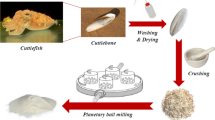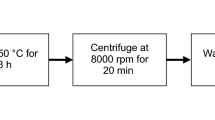Abstract
High interfacial tension (IFT) between oil and water brings about high capillarity leading to high residual oil saturation. Surfactants are employed to reduce IFT or modify wettability and mobilize the trapped oil. This paper aims to investigate the interaction of sodium dodecyl sulfate as a surfactant and two types of silica nanoparticles in different particle sizes for the purpose of enhancing oil recovery. Accordingly, the effect of employed nanoparticles on the critical micelle concentration (CMC) of the surfactant was investigated by the use of electrical conductivity measurements. Phase behavior studies were also carried out to examine the solubilizing ability of the surfactant and nanoparticles assembly. Based on the analysis of solubilization curves, an ultra-low IFT chemical formulation for the target reservoir crude oil was identified and the stability of the optimum solutions was examined through visual observation, optical absorption, and zeta potential measurements. The oil recovery experiments were performed in a quarter five-spot transparent pore network model saturated with crude oil to observe the displacement behavior of the injectant and its influence on oil recovery. Phase behavior tests indicated that the silica nanoparticles smaller in size are more effective in terms of IFT reduction since they can achieve ultra-low IFT level, and the conductivity measurements showed they relatively reduce the CMC of the surfactant. The results of stability tests demonstrated the optimum solutions are stable for more than 1 week. The micromodel experiments displayed that oil recovery increased by 4% during nanoparticles-assisted surfactant flood in comparison with surfactant flood.
Similar content being viewed by others
Abbreviations
- 2D:
-
2-Dimensional
- ASP:
-
Alkaline–surfactant–polymer flood
- CSEL:
-
Lower effective salinity window
- CSEU:
-
Upper effective salinity window
- TEM:
-
Transmission electron microscope
- UTCHEM:
-
The University of Texas at Austin Chemical Flood Simulator
- HBNC70:
-
UTCHEM input parameter for surfactant model (intercept of maximum height of binodal curve at zero salinity [44])
- HBNC71:
-
UTCHEM input parameter for surfactant model (intercept of maximum height of binodal curve at optimal salinity [44])
- HBNC72:
-
UTCHEM input parameter for surfactant model (intercept of maximum height of binodal curve at twice optimal salinity [44])
- CSEL7:
-
UTCHEM input parameter for surfactant model (lower critical salinity window [44])
- CSEU7:
-
UTCHEM input parameter for surfactant model (upper critical salinity window [44])
References
Sharma, H.; Panthi, K.; Mohanty, K.K.: Surfactant-less alkali-cosolvent-polymer floods for an acidic crude oil. Fuel 215, 484–491 (2018). https://doi.org/10.1016/j.fuel.2017.11.079
Sheng, J.: Modern Chemical Enhanced Oil Recovery: Theory and Practice. Gulf Professional Publishing, Elsevier, Burlington (2011)
Dashti, G.: A Study of Microemulsion Viscosity with Consideration of Polymer and Co-solvents Additives. M.S. Thesis, The University of Texas at Austin, Austin, Texas (May 2014)
Karambeigi, M.S.; Nasiri, M.; Haghighi Asl, A.; Emadi, M.A.: Enhanced oil recovery in high temperature carbonates using microemulsions formulated with a new hydrophobic component. J. Ind. Eng. Chem. 39, 136–148 (2016). https://doi.org/10.1016/j.jiec.2016.05.020
Jin, L.; Budhathoki, M.; Jamili, A.; Li, Zh.; Luo, H.; Delshad, M.; Shiau, B.; Harwell, J.H.: Predicting microemulsion phase behavior for surfactant flooding. In: Paper SPE 179701 (2016). https://doi.org/10.2118/179701-MS
Winsor, P.A.: Solvent Properties of Amphiphilic Compounds. Butterworth Scientific Publications, London (1974)
Yassin, M.R.; Ayatollahi, S.; Rostami, B.; Hasani, K.: Micro-emulsion phase behavior of a cationic surfactant at intermediate interfacial tension in sandstone and carbonate rocks. J. Energy Resour. Technol. 137, 012905–012917 (2015)
Healy, R.N.; Reed, R.L.: Immiscible microemulsion flooding. SPE J. 17, 129–139 (1977). https://doi.org/10.2118/5817-PA
Nelson, R.C.; Pope, G.A.: Phase relationship in chemical flooding. SPE J. 18, 325–338 (1978). https://doi.org/10.2118/6773-PA
Lu, J.; Goudarzi, A.; Chen, P.; Kim, D.H.; Delshad, M.; Mohanty, K.K.; Sepehrnoori, K.; Weerasooriya, U.P.; Pope, G.A.: Enhanced oil recovery from high-temperature, high-salinity naturally fractured carbonates reservoirs by surfactant flood. J. Pet. Sci. Eng. 124, 122–131 (2014). https://doi.org/10.1016/j.petrol.2014.10.016
Kamal, M.S.; Hussein, I.A.; Sultan, A.S.: Review on surfactant flooding: phase behavior, retention, IFT, and field applications. Energy Fuels 31, 7701–7720 (2017)
Huh, C.: Interfacial tensions and solubilizing ability of a microemulsion phase that coexist with oil and brine. J. Colloid Interface Sci. 71, 408–426 (1979). https://doi.org/10.1016/0021-9797(79)90249-2
Nelson, R.C.: The effect of live crude on phase behavior and oil-recovery efficiency of surfactant flooding. SPE J. 23, 501–510 (1983). https://doi.org/10.2118/10677-PA
Escontrla, I.R.; Puetro, M.C.; Miller, C.A.; Soto, A.: Ionic liquids for low-tension oil recovery processes: phase behavior tests. J. Colloid Interface Sci. 504, 404–416 (2017). https://doi.org/10.1016/j.jcis.2017.05.102
Healy, R.N.; Reed, R.L.; Carpenter Jr., C.W.: A laboratory study of microemulsion flooding. SPE J. 15, 87–103 (1975). https://doi.org/10.2118/4752-PA
Hirasaki, G.J.; Van Domselaar, H.R.; Nelson, R.C.: Evaluation of the salinity gradient concept in surfactant flooding. SPE J. 23, 486–500 (1983). https://doi.org/10.2118/8825-PA
Levitt, D.B.; Jackson, A.C.; Heinson, C.; Britton, L.N.; Malik, T.; Dwarakanath, V.; Pope, G.A.: Identification and evaluation of high-performance EOR surfactants. SPE Reserv. Eval. Eng. 12, 243–253 (2006). https://doi.org/10.2118/100089-PA
Dwarakanath, V.; Chaturvedi, T.; Jackson, A.C.; Malik, T.; Siregar, A.; Zhao, P.: Using co-solvents to provide gradients and improve oil recovery during chemical flooding in a light oil reservoir. In: Paper SPE 113965 (2008). https://doi.org/10.2118/113965-MS
Awang, M.B.; Dzulkarnani, I.B.; Wahyudeen, B.Z.M.: Enhancement of IFT reduction in surfactant flooding by branched alcohols. In: Paper IPTC 15140 (2011). https://doi.org/10.2523/IPTC-15140-MS
Khalilinezhad, S.S.; Cheraghian, G.; Roayaei, E.; Tabatabaee, H.; Karambeigi, M.S.: Improving heavy oil recovery in the polymer flooding process by utilizing hydrophilic silica nanoparticles. Energy Sour. Part A Recov. Util. Environ. Eff. (2017). https://doi.org/10.1080/15567036.2017.1302521 (in press)
Khalilinezhad, S.S.; Cheraghian, G.; Karambeigi, M.S.; Tabatabaee, H.; Roayaei, E.: Characterizing the role of clay and silica nanoparticles in enhanced heavy oil recovery during polymer flooding. Arab. J. Sci. Eng. 41, 2731–2750 (2016). https://doi.org/10.1007/s13369-016-2183-6
Zargartalebi, M.; Kharrat, R.; Barati, N.: Enhancement of surfactant flooding performance by the use of silica nanoparticles. Fuel 143, 21–27 (2015). https://doi.org/10.1016/j.fuel.2014.11.040
Zargartalebi, M.; Barati, N.; Kharrat, R.: Influences of hydrophilic and hydrophobic silica nanoparticles on anionic surfactant properties: interfacial and adsorption behaviors. J. Pet. Sci. Eng. 119, 36–43 (2014). https://doi.org/10.1016/j.petrol.2014.04.010
Vatanparast, H.; Javadi, A.; Bahramian, A.: Silica nanoparticles cationic surfactants interaction in water–oil system. Colloids Surf. A Physicochem. Eng. Asp. 521, 221–230 (2017). https://doi.org/10.1016/j.colsurfa.2016.10.004
Biswal, N.R.; Rangera, N.; Singh, J.K.: Effect of different surfactants on the interfacial behavior of the \(n\)-Hexane-Water system in the presence of silica nanoparticles. J. Phys. Chem. B 120, 7265–7274 (2016)
Esmaeilizadeh, P.; Hosseinipour, N.; Bahramian, A.; Fakhroueian, Z.; Arya, Sh: Effect of \(\text{ ZrO }_{2}\) nanoparticles on the interfacial behavior of surfactants at air–water and \(n\)-Heptane-Water interfaces. Fluid Phase Equilib. 361, 289–295 (2014). https://doi.org/10.1016/j.fluid.2013.11.014
Ahmadi, M.-A.; Ahmed, Z.; Phung, L.T.K.; Kashiwao, T.; Bahadori, A.: Evaluation of the ability of the hydrophobic nanoparticles of \(\text{ SiO }_{2}\) in the EOR process through carbonate rock samples. Pet. Sci. Technol. 34, 1048–1054 (2016). https://doi.org/10.1080/10916466.2016.1148052
AlamiNia, H.; Khalilinezhad, S.S.: Application of Hydrophilic Silica Nanoparticles in Chemical Enhanced Oil Recovery Processes. Energy Sources Part A Recovery Util. Environ. Eff. (2017). https://doi.org/10.1080/15567036.2017.1299257 (in press)
Ahmadi, M.-A.; Ahmed, Z.; Phung, L.T.K.; Kashiwao, T.; Bahadori, A.: Experimental investigation of the effect of nanoparticles on micellization behavior of a surfactant: application to EOR. Pet. Sci. Technol. 34, 1055–1061 (2016). https://doi.org/10.1080/10916466.2016.1148051
Cheraghian, G.; Khalilinezhad, S.S.: Improvement of heavy oil recovery and role of nanoparticles of clay in the surfactant flooding process. Pet. Sci. Technol. 34, 1397–1405 (2016). https://doi.org/10.1080/10916466.2016.1198805
Ahmadi, M.A.: Use of nanoparticles to improve the performance of sodium dodecyl sulfate flooding in a sandstone reservoir. Eur. Phys. J. Plus 131, 435 (2016). https://doi.org/10.1140/epjp/i2016-16435-5
Cheraghian, G.; Kiani, S.; Nassar, N.N.; Alexander, S.; Barron, A.: Silica nanoparticles enhancement in the efficiency of surfactant flooding of heavy oil in a glass micromodel. Ind. Eng. Chem. Res. 56, 8528–8534 (2017)
Khorsand, H.; Kiayee, N.; Masoomparast, A.H.: Optimization of amorphous silica nanoparticles synthesis from rice straw ash using design of experiment technique. Part. Sci. Technol. 31, 366–371 (2013). https://doi.org/10.1080/02726351.2012.755587
Jafari, V.; Allahverdi, A.; Vafaei, M.: Ultrasound-assisted synthesis of colloidal nanosilica from silica fume: effect of sonication time on the properties of product. Adv. Powder Technol. 25, 1571–1577 (2014). https://doi.org/10.1016/j.apt.2014.05.011
Metin, C.O.; Lake, L.W.; Miranda, C.R.; Nguyen, Q.P.: Stability of aqueous silica nanoparticles dispersions. J. Nanopart. Res. 13, 839–850 (2011)
Ahmadi, M.-A.; Sheng, J.: Performance improvement of ionic surfactant flooding in carbonate rock samples by use of nanoparticles. Pet. Sci. 13, 725–736 (2016). https://doi.org/10.1007/s12182-016-0109-2
https://www.kruss.de/fileadmin/user_upload/website/brochures/kruss-bro-k100-en.pdf
Ghahremani, H.; Mobaraki, S.; Khalilinezhad, S.S.; Jarrahian, K.: An experimental study of the performance of low-molecular weight polymer for enhanced heavy oil recovery in a heterogeneous media. Geosyst. Eng. 21, 95–102 (2017). https://doi.org/10.1080/12269328.2017.1385424
Mohammadi, S.; Maghzi, A.; Ghazanfari, M.H.; Masihi, M.; Mohebbi, A.; Kharrat, R.: On the control of glass micromodel characteristics developed by laser technology. Energy Resources Part A Recovery Utili. Environ. Eff. 35, 193–201 (2013). https://doi.org/10.1080/15567036.2010.516325
Khalilinezhad, S.S.; Cherghian, G.: Mechanisms behind injecting the combination of nano-clay particles and polymer solution for enhanced oil recovery. Appl. Nanosci. 6, 923–931 (2016). https://doi.org/10.1007/s13204-015-0500-0
Levitt, D.: Experimental Evaluation of High Performance EOR Surfactants for a Dolomite Oil Reservoir. M.S. Thesis, The University of Texas at Austin, Austin, Texas (2006)
Flaaten, A.; Nguyen, Q.P.; Pope, G.A.; Zhang, J.: A systematic laboratory approach to low-cost, high-performance chemical flooding. SPE Reserv. Eval. Eng. 12, 713–723 (2009). https://doi.org/10.2118/113469-PA
Emami Meybodi, H.; Kharrat, R.; Wang, X.: Study of microscopic and macroscopic displacement behaviors of polymer solution in water-wet and oil-wet media. Transp. Porous Media 89, 97–120 (2011). https://doi.org/10.1007/s11242-011-9754-5
UTCHEM-9.0.: A Three-Dimensional Chemical Flood Simulator, Volumes 1 and 2, Reservoir Engineering Research Program, Center for Petroleum and Geosystems Engineering. The University of Texas, Austin (2000)
Goudarzi, A.; Delshad, M.; Sepehrnoori, K.: A chemical EOR benchmark study of different reservoir simulators. Comput. Geosci. 94, 96–109 (2016). https://doi.org/10.1016/j.cageo.2016.06.013
Anderson, G.A.: Simulation of Chemical Flood Enhanced Oil Recovery Processes Including the Effects of Reservoir Wettability. M.S. Thesis, The University of Texas at Austin, Austin, Texas (2006)
Green, D.W.; Willhite, G.P.: Enhanced oil recovery. In: Memorial Found, Society of Petroleum Engineers. The University of Kansas, Lawrence, Kansas (1998)
Healy, R.N.; Reed, R.L.: Physicochemical aspects of microemulsion flooding. SPE J. 14, 491–501 (1974). https://doi.org/10.2118/4583-PA
Hand, D.B.: Dineric distribution: I. The distribution of a consolute liquid between immiscible liquids. J. Phys. Chem. 34, 1961–2000 (1939)
Veedu, F.K.: Scale-Up Methodology for Chemical Flooding. M.S. Thesis, The University of Texas at Austin, Austin, Texas (2010)
Mohammadi, H.; Delshad, M.; Pope, G.A.: Mechanistic modeling of alkaline/surfactant/polymer floods. SPE Reserv. Eval. Eng. 12, 518–527 (2009). https://doi.org/10.2118/110212-PA
AlSofi, A.M.; Liu, J.S.; Han, M.; Aramco, S.: Numerical simulation of surfactant-polymer coreflooding experiments for carbonates. J. Pet. Sci. Eng. 111, 184–196 (2013). https://doi.org/10.1016/j.petrol.2013.09.009
Ravera, F.; Santini, E.; Loglio, G.; Ferrari, M.; Liggieri, L.: Effect of nanoparticles on the properties of liquid/liquid and liquid/air surface layers. J. Phys. Chem. B 110, 19543–19551 (2006)
Ahualli, S.; Iglesias, G.R.; Wachter, W.; Dulle, M.; Minami, D.; Glaatter, O.: Adsorption of anionic and cationic surfactants on anionic colloids: supercharging and destabilization. Langmuir 27, 9182–9192 (2011)
Azadgoleh, J.E.; Kharrat, R.; Barati, N.; Sobhani, A.: Stability of silica nanoparticle dispersion in brine solution: an experimental study. Iran. J. Oil Gas Sci. Technol. 3, 26–40. (2014) http://ijogst.put.ac.ir/article_7485.html
Acknowledgements
The work was financially sponsored by Eqbal Lahoori Institute of Higher Education, in Mashhad (Iran). We would like to thank Nanosany Corporation for providing the authors with some laboratory materials. The authors thank Research Institute of Food Science and Technology (RIFST), in Mashhad, and Petro Ahoura Company, in Tehran, for the provision laboratory facilities. We would like to thank ESSS for providing the post-processor software needed to complete this work.
Author information
Authors and Affiliations
Corresponding author
Rights and permissions
About this article
Cite this article
Khalilinezhad, S.S., Mobaraki, S., Zakavi, M. et al. Mechanistic Modeling of Nanoparticles-Assisted Surfactant Flood. Arab J Sci Eng 43, 6609–6625 (2018). https://doi.org/10.1007/s13369-018-3415-8
Received:
Accepted:
Published:
Issue Date:
DOI: https://doi.org/10.1007/s13369-018-3415-8




